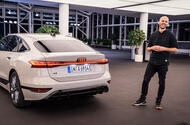How does Audi’s lighting chief approach the art of car light design?
Christoph Häußinger, the creative force behind Audi’s latest lighting innovations, doesn’t just see headlights and taillights as functional necessities. For him, lighting is the soul of a car’s personality. He likens his process to that of a graphic designer—first sketching the overall light graphic, then shaping the character of the car, and finally diving into materials and hardware. But his favorite part? Crafting those digital welcome scenarios and animations that greet drivers, a feature that’s become a signature of the new all-electric Audi A6 e-tron and Q6 e-tron.
What does Vorsprung durch Technik mean on a personal level?
For Häußinger, Audi’s iconic slogan—Vorsprung durch Technik, or progress through technology—isn’t just a corporate mantra. It’s a mindset. He describes it as a relentless curiosity, a drive to keep exploring and questioning what’s next. This philosophy isn’t just about chasing the latest tech for its own sake; it’s about using innovation to create something genuinely better, more beautiful, and more meaningful for drivers.
Where does inspiration for cutting-edge car lighting come from?
You might expect a lighting designer to draw from the world of engineering or architecture, but Häußinger’s influences are refreshingly diverse. He’s inspired by great product design—think high-end consumer electronics or luxury watches, where every detail matters. But he also finds ideas in the most human of places: faces. He points out that people instinctively look for faces everywhere, even in cars. That’s why the “eyes” of a car—the headlights—are so crucial in giving each model its unique expression.
Why is lighting design so vital to a car’s identity?
Light isn’t just about seeing and being seen. It’s about emotion, safety, and storytelling. Häußinger argues that without light, there’s no life—an idea rooted in both biology and design. The way a car’s lights are shaped and animated can completely transform its character. Audi’s design teams even talk about the “eyes” of the car, asking: How does this vehicle look at you? Does it appear sporty, elegant, aggressive, or friendly? The right lighting can make all the difference.
Which Audi models have set the standard for lighting innovation?
Audi has a long history of pushing boundaries in lighting technology. Häußinger singles out the 2013 Audi A8 as a milestone, thanks to its pioneering Matrix LED headlights. This was the first time Audi managed to blend cutting-edge tech with a design that didn’t even look like a traditional car light. Another standout is the third-generation Audi TT, with its iconic twin vertical lines—a sporty, instantly recognizable signature.
How do lighting and exterior design teams collaborate at Audi?
Creating a seamless look between a car’s body and its lights is no small feat. Häußinger describes a hands-on, collaborative process. He’ll walk around the car with exterior designers, discussing the volumes and outlines, and figuring out how the lights can enhance the car’s shape. For the A6 e-tron, for example, the goal was to extend the car’s shoulder line all the way to the lights, creating a cohesive, athletic stance. The Q6 e-tron takes this even further, with lines that flow effortlessly into the headlight design.
What makes the Audi A6 e-tron’s front lighting so groundbreaking?
Audi’s latest A6 e-tron breaks new ground with its ultra-slim headlights. To achieve this focused, sporty look, Häußinger’s team relocated the high and low beams lower down in the bumper, hidden behind a sleek black mask. This left only the daytime running lights and indicators in the traditional headlight position, arranged horizontally to emphasize the car’s width. The result? The slimmest, most striking headlight Audi has ever produced.
But it’s not just about looks. For the first time, drivers can fully customize the lighting graphics at the front of the car, choosing from multiple signatures via their smartphone or the MMI touchscreen. This level of personalization lets owners subtly tweak the car’s character while keeping that unmistakable Audi DNA.
How does rear lighting technology enhance both style and safety?
At the back, the A6 e-tron features a dramatic wraparound lightbar that makes the car look wider and more futuristic. The real magic, though, lies in the OLED 2.0 technology. Originally introduced on the Q6 e-tron, this next-gen system uses more pixels and higher resolution to create vivid, fluid animations—lights that are always in motion, always communicating.
Safety is front and center, too. The A6 e-tron’s rear lights can display warning triangles when the hazard lights are activated, or if the car detects a crash or a vehicle approaching too closely from behind. This isn’t just clever design—it’s a leap forward in how cars communicate with each other on the road.
What’s next for Audi lighting and Vorsprung durch Technik?
The future of Audi lighting is wide open, and Häußinger is clearly excited about what’s to come. With rapid advances in digitalization, materials, and interactive features, the possibilities for expressing a car’s character—and keeping drivers safer—are expanding fast. Audi’s commitment to progress through technology means we can expect even more innovative, expressive lighting in the years ahead.
The big takeaway? Lighting design isn’t about perfection—it’s about smarter adjustments. Start with one change this week, and you’ll likely spot the difference by month’s end.

